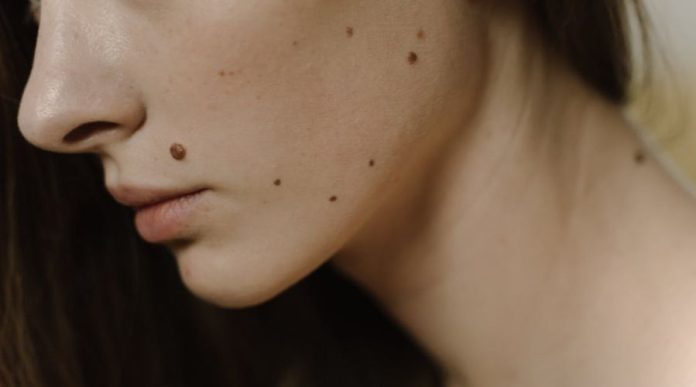Is DIY mole and skin tag removal safe? Medical advice would say, “no.”
What are skin tags?
Skin tags equally affect 50% of men and women.5 Skin tags are medically known as acrochordons and typically appear in adulthood. However, skin tags are now appearing in childhood.5 The rise in children with skin tags may be due to the increase of childhood obesity; the relationship is that skin tags are commonly found in those living with:
- obesity,
- diabetes,
- metabolic disorders,
- or a family history of skin tags.5
Skin tags are made of loose collagen fibers and grow on thicker areas of the skin.3 Skin tags also occur in folds and with frequent skin-to-skin contact like, in the armpit.5 Tags are typically 0.1 cm to 0.5 cm but can grow upwards of 1 cm to 2 cm.5
On a positive note, skin tags are harmless. Still, they may become bothersome caught on jewelry or clothing.3 These harmless tags can be bothersome, creating a desire to remove them. Removal is possible but should only be done by a medical professional. Additionally, seeing a doctor or dermatologist when you notice a skin tag is essential, as it could be a mole.
What is this mole?
Many develop moles before their twenties, and often they are just decorative, or to some, uncomfortable. Because the appearance of a mole can be a discomfort, some look for quick ways to remove it. This need for a fast solution is problematic
There can be uncertainty if a mole is skin cancer (melanoma). Because of this uncertainty, it’s crucial to see a doctor. A questionable mole needs a biopsy to determine if it is cancerous.4
Even if the mole is not melanoma, there are risks with removing it yourself.4 An individual should see a physician or dermatologist to determine the best action for removal.
Mole and skin tag removal products
Experts urge not to use mole and skin tag removal products.4 Such products can lead to scarring and infection and may also hide cancerous.4 By masking cancerous lesions, it’s difficult for doctors to detect skin cancer in certain cases.4 Individuals should be conscious of what they purchase over-the-counter (OTC) to remove moles and skin tags.
Despite positive claims, these products can cause harm.1 Even products labeled ‘natural’ or ‘organic’, doesn’t mean they are safe.6 In June of 2022, the FDA released an advisory for over-the-counter products that don’t require a prescription.4
Dangers of these products
As we age, we may acquire new, undesirable skin growths; however, this does not mean it is safe to conduct a DIY removal. Currently, no OTC skin tag and mole removal products are approved by the FDA and in addition, they may contain harmful ingredients.6 As of August 2022, warnings were issued to sellers like Amazon from the FDA regarding the sale of these products.6
These products have not been evaluated by the FDA or Health Canada for safety. Moreover, health protection organizations advise customers not to purchase these products.6 These products can lead to permanent skin injury, and serious infection. Additionally, using these products instead of seeking out a professional, can delay skin cancer diagnosis and treatment.6
Case Review
One such product sold on Amazon was the “Ariella Mole Corrector and Skin Tag Remover and Repair Lotion Set”.5 This product had made claims that it could be used for 7-10 days and could be used on any skin type.5 The product line also advertised before and after photos of customers on Amazon.5
Despite the product claims and positive advertising, which can easily be falsified, there were serious adverse events from the use of the product. One 45-year-old woman presented to a clinic with multiple necrotic skin ulcerations meaning that her skin turned black because the tissue died.2,5
Her physician-led treatment plan was to reduce scar formation caused by the ulcerations and to seek scar removal via laser-based equipment.5 Thankfully, the “Ariella Mole and Skin Tag Remover” product is no longer available for sale on Amazon.5
Conclusion
After reviewing cases and medical advice on the skin tag and mole removal, one should look toward having these lesions removed by a physician. The question of how moles and skin tags should be removed doesn’t support DIY methods. It’s best that a professional does the removal.
References
- Pandey A, Sonthalia S. Skin Tags. (Updated 2022 Aug 1). In: StatPearls [Internet]. Treasure Island (FL): StatPearls Publishing; 2022 Jan-. Available from: https://www.ncbi.nlm.nih.gov/books/NBK547724/
- Fisher MH, Hill MK, Hugh J. Necrotic ulcerations after the use of an over-the-counter mole and skin tag removal product. Cutis. 2022;109(2):E27-E28. doi:10.12788/cutis.0483
- Murez, C. Products to Remove Moles, Skin Tags Can Be Harmful. WebMD. Updated June 20, 2022. Accessed November 22, 2022. https://www.webmd.com/skin-problems-and-treatments/news/20220620/skin-tags-moles-products-promising-to-treat-them-can-do-real-harm
- Higuera, V, Robinson, D. Everything to Know About Skin Tag removal. Healthline. Updated January 27, 2022. Accessed November 22, 2022. https://www.healthline.com/health/skin-tag-removal
- U.S. Food & Drug Administration. Products Marketed for Removing Moles and Other Skin Lesions Can Cause Injuries, Scarring. FDA. Updated August 10, 2022. Accessed November 22, 2022. https://www.fda.gov/consumers/consumer-updates/products-marketed-removing-moles-and-other-skin-lesions-can-cause-injuries-scarring
- Healthwise Staff. Removing Moles and Skin Tags. MyHealth.Alberta.ca. Updated November 15, 2021. Accessed November 22, 2022. https://myhealth.alberta.ca/Health/Pages/conditions.aspx?hwid=abk9606



